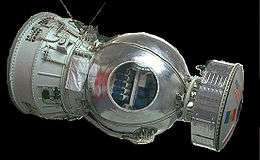Kosmos 690
Kosmos 690 (in Russian: Бион 2, Космос 690), or Bion 2, was a Bion satellite launched by the Soviet Union.
 The Bion spacecraft | |
| Mission type | Bioscience |
|---|---|
| Operator | Institute of Biomedical Problems |
| COSPAR ID | 1974-080A |
| SATCAT no. | 7478[1] |
| Mission duration | 20.5 days |
| Spacecraft properties | |
| Spacecraft type | Bion |
| Manufacturer | TsSKB |
| Launch mass | 5,500 kg (12,100 lb) |
| Start of mission | |
| Launch date | 20 October 1974, 17:59:59 UTC[2] |
| Rocket | Soyuz-U K 15000-010 [2] |
| Launch site | Plesetsk 43/4 |
| End of mission | |
| Landing date | 12 November 1974, 04:48 UTC |
| Landing site | Kazakhstan, Soviet Union |
| Orbital parameters | |
| Reference system | Geocentric |
| Regime | Low Earth |
| Eccentricity | 0.01241[3] |
| Perigee altitude | 223 kilometres (139 mi)[3] |
| Apogee altitude | 389 kilometres (242 mi)[3] |
| Inclination | 62.8 degrees[3] |
| Period | 90.4 minutes[3] |
| Epoch | 22 October 1974[3] |
Launch
Kosmos 690 was launched on 22 October 1974 from Plesetsk Cosmodrome with a Soyuz-U rocket. It was placed in low earth orbit, with apogee of 389 kilometres (242 mi), perigee of 223 kilometres (139 mi) and orbital inclination of 62.8 degrees.[3]
Mission
The spacecraft was based on the Zenit spy satellite with emphasis on studying the problems of radiation effects on human beings.
It carried albino rats for biomedical research. Scientists from Czechoslovakia, Romania and Soviet Union subjected the rats to daily radiation doses from a gamma source by ground command. When they were recovered 21 days later, many rats had developed lung problems and their blood and bone marrow had changed more than those of control specimens. It had an on-orbit dry mass of 12,100 pounds (5,500 kg).[4][5]
An instrument module in the form of 2 connected truncated cones, weighing 5,300 pounds (2,400 kg), 2.43 metres (8.0 ft) in diameter and 2.25 metres (7.4 ft) in length, carries in most of the auxiliary instrumentation in the hermetized part. Outwardly, ball valves with compressed nitrogen are attached to the gas nozzles of the stabilizer system. At the rear, the TDU-1 braking engine is located at a stroke of 15.83 kN and a maximum operating time of 45 seconds. Hypergolic KPL delivers a turbo pump to the combustion chamber. An auxiliary container containing chemical batteries and additional experiments, cylindrical with a diameter of 1.90 metres (6.2 ft) and a height of 0.90 metres (3.0 ft) is placed above the return module and dumped approximately a day before the landing.
End of mission
After 21 days, Kosmos 690 returned to Earth and landing in Kazakhstan on 12 November 1974. The return module, weighing 3,100 kilograms (6,800 lb) and 2.3 metres (7.5 ft) in diameter, was covered with an ablative thermal shield 30 to 180 mm thick.[5]
See also
References
- "Cosmos 690". N2yo.com. Retrieved 10 June 2016.
- McDowell, Jonathan. "Launch Log". Jonathan's Space Page. Retrieved 22 July 2018.
- NASA Goddard Space Flight Center. "NASA NSSDCA Spacecraft Telemetry Details". NSSDCA Master Catalog. Retrieved 16 May 2020.
- Mark Wade (2011). Bion Archived 2002-08-20 at the Wayback Machine. Encyclopedia Astronautica. Retrieved 2016-06-10.
- "Bion 2". National Space Science Data Center. NASA GSFC. Retrieved 10 June 2016.
Bibliography
- Kozlov, D I (1996). Mashnostroenie, ed. Konstruirovanie avtomaticheskikh kosmicheskikh apparatov. Moscow. ISBN.
- Melnik, T G (1997). Nauka, ed. Voenno-Kosmicheskiy Sili. Moscow. ISBN.
- "Bion' nuzhen lyudyam". Novosti Kosmonavtiki (6): 35. 1996.